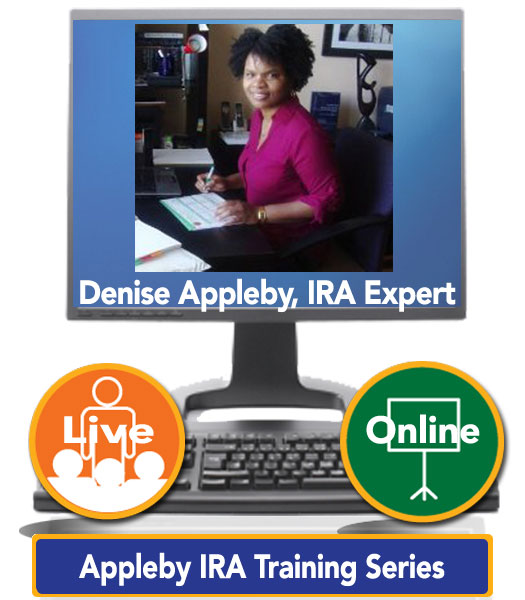By Denise Appleby, MJ, CISP, CRC®, CRPS, CRSP, APA, Founder and Owner of Appleby Retirement Consulting, Inc.
If you are one of the many financial/tax professionals who have been seeking clarity about converting after-tax amounts to Roth IRAs tax-free, IRS Notice 2014-54, issued September 18, 2014, provides welcome answers.
While there was never any question that after-tax amounts can be converted to Roth IRAs tax-free, there was uncertainty about whether such an objective could be accomplished without either including pre-tax amounts, or by using a three-step process which required the payor to withhold 20% of the pre-tax amount for federal income tax. IRS Notice 2014-54 makes it clear that the objective can be accomplished with a one-step process without any tax withholding.
Note: After-tax amounts accrued before 1987 are not subject to the pro-rata rule. As such, this article focuses on after-tax amounts contributed after 1986.
Effective Date
The rules provided in Notice 2014-54 become effective for distributions processed January 1, 2015 and after. However, transitional rules have been included for distributions processed before then.
Previous Guidance- IRS Notice 2009-68
The IRS issued IRS Notice 2009-68 in 2009, which included language that plan administrators could include in distribution notices to recipients of eligible rollover distributions. In part, Notice 2009-68 provided that if a distribution from a qualified plan or 403(b) is split between a direct rollover and a distribution to the participant, each payment would include a pro-rata amount of any after-tax and pre-tax funds. It also provided that if a participant receives a distribution to him or herself, and rolls over a portion of the distribution, the amount rolled over would come from the pre-tax amount first.
The following example was provided in Notice 2009-68:
“Assume you are receiving a complete distribution of your benefit which totals $12,000, of which $2,000 is after-tax contributions. In this case, if you roll over $10,000 to an IRA in a 60-day rollover, no amount is taxable because the $2,000 amount not rolled over is treated as being aftertax contributions”.
While the IRS did not address the issue of splitting a direct rollover between a Roth IRA and a traditional IRA, many felt that without guidance that said otherwise, so the only way to complete a tax-free Roth conversion of after-tax amounts ( from a qualified plan or 403(b)), was to use the following three step process:
- The amount distributed is paid to the participant.
- The participant rolls over the pre-tax amounts to a traditional IRA. The remaining amount would be after-tax funds
- The participant rolls over the after-tax amount to a Roth IRA as a conversion
The challenge with this method is that the payor would be required to withhold 20% of the pre-tax amount for federal income tax. And, for those who also perform state tax withholding, the required tax-withholding amount could be more than 20%. In such cases, participants who wanted to rollover the entire withdrawal would need to make up the taxes withheld out of pocket. For those who could not afford to do so, the rollover would be short the withholding tax amount.
Example:
Assume that Jim has a 401(k) balance of $500,000, of which $100,000 is after-tax.
If Jim requests to have the $500,000 paid to him, the plan administrator would be required to withhold $80,000 for federal income tax ($400,000 x 20%).
Jim would receive only $420,000.
In order to rollover the entire $500,000, Jim would need to make-up the $80,000 out of pocket.
IRS Notice 2014-54 Provides More Favorable Solutions
According to Notice 2014-54, distributions from a qualified plan or 403(b) that are scheduled to be paid at the same time are treated as a single distribution, even if the amount is paid to multiple locations. This allows pre-tax and after tax amounts to be segregated when paid to multiple locations, instead of each amount including a pro-rata allocation (of the pretax and after tax amounts).
Notice 2014-54 also provides that if a portion of a distribution is processed as a direct rollover to an eligible retirement account, and a portion paid to the participant, the pre-tax portion of the account balance would be allocated to the direct rollover first. The same treatment would be applied to an amount paid to the participant, when a portion of that distribution is rolled over within 60-days of receipt (60-day rollover).
Finally, participants can choose how pre-tax and after-tax amounts are allocated among direct rollovers to multiple retirement plans. In such cases, the participant must inform the plan administrator of the allocation prior to the direct rollovers being processed.
The following are examples of options available to participants with after-tax and pretax amounts in a qualified plan or 403(b) account.
Example:
Assume that Jim has a 401(k) balance of $500,000, of which $100,000 is after-tax. The following are some of the options available to Jack, and the instructions he would provide to the plan administrator.
Objective 1: No income tax owed and tax-free conversion of $100,000
- Submit instructions for withdrawal of $500,000
- Instruct plan administrator to split amount as follows:
- Direct rollover of $400,000 in pre-tax amount to traditional IRA. No tax withholding would apply. Amount would continue to be tax-deferred. Earnings would grow tax-deferred
- Direct rollover of $100,000 of after-tax amount to Roth IRA. No tax withholding would apply. Transaction would be tax-free. Qualified distributions would be tax-free
Objective 2: No income tax owed and tax-free distribution or conversion of $100,000
- Submit instructions for withdrawal of $500,000
- Instruct plan administrator to split check as follows:
- Direct rollover of $400,000 in pre-tax amount to traditional IRA. No tax withholding would apply. Amount would continue to be tax-deferred. Earnings would grow tax-deferred
- Distribution to Jack of $100,000 in after-tax amount. No tax withholding would apply. Transaction would be tax-free. Jack can keep amount or rollover amount within 60-days. If the amount is rolled over to a Roth IRA, it would result in a tax-free conversion. Qualified distributions would be tax-free
Objective 3: Mandatory 20% tax withholding, tax-deferment of pre-tax amount and tax-free conversion
- Submit instructions for withdrawal of $500,000
- Instruct plan administrator to distribute entire $500,000 to Jack. Plan administrator must withhold 20% ($80,000) of the pretax amount of $400,000.
- Jack receives only $420,000.
- Jack rolls over $400,000 to his traditional IRA. This would come from the pre-tax amount. Amount would continue to be tax-deferred. Earnings would grow tax-deferred
- Jack has $20,000 remaining, all of which is after-tax. Jack can:
- Make up the $80,000 out of pocket and rollover $100,000 to a Roth IRA. All of this would be after-tax. Conversion would be tax-free. Qualified distribution would be tax-free
- Make up less than $80,000 and rollover the amount to a Roth IRA. All of this would be after-tax. Conversion would be tax-free. Qualified distribution would be tax-free
- Rollover the $20,000 to a Roth IRA. All of this would be after-tax. Conversion would be tax-free. Qualified distribution would be tax-free
Any amount not rolled over would still be nontaxable, as it would come from the after-tax amount of $100,000.
Any amount withheld is paid to the IRS as an advance tax withholding amount for Jack.
Objective 4: Split after-tax and pre-tax between traditional IRA and Roth IRA
- Submit instructions for withdrawal of $500,000
- Instruct plan administrator to split amount as follows:
- Direct rollover of $400,000 to traditional IRA – $350,000 pre-tax and $50,000 after-tax. No tax withholding would apply. Amount would continue to be tax-deferred. Earnings would grow tax-deferred.
- Any subsequent distribution or Roth conversion from any of the individual’s Traditional, SEP or SIMPLE IRA will include a pro-rata amount of pretax and after tax amounts. IRS Form 8606 must be filed for any such distributions or conversions, so as to ensure that the after-tax portion is nontaxable.
- Direct rollover of $100,000 to Roth IRA. $50,000 pre-tax and $50,000 after-tax No tax withholding would apply. $50,000 would be taxable. Qualified distributions would be tax-free
- Direct rollover of $400,000 to traditional IRA – $350,000 pre-tax and $50,000 after-tax. No tax withholding would apply. Amount would continue to be tax-deferred. Earnings would grow tax-deferred.
While these examples show rollovers to traditional IRAs and Roth IRAs, eligible amounts can be rolled over to qualified plans such as 401(k) plans, 403(b) plans and governmental 457(b) plans as well. After-tax amounts can be rolled over to a qualified plan or 403(b), only if done as a direct rollover, and only if allowed under the plan. After-tax amounts cannot be rolled over to a 457(b) plan.
Distributions before January 1, 2015
For distributions from qualified plans or 403(b)s that occur before January 1 2015, the rules as explained above can be applied to the transaction. Clients should obtain confirmation from plan administrators regarding the approach they – the plan administrators – will take, and ensure that the tax reporting done of their tax return corresponds to the plan administrator’s.
Final Note: IRA Distributions Not Affected
The rules explained above apply to distributions from qualified plans and 403(b) plans. They do not apply to distributions from IRAs. As such, the pro-rata rule that applies to distributions from traditional, SEP and SIMPLE IRAs, when the owner’s traditional IRA balance includes basis still applies.

About Denise Appleby, APA, CISP, CRPS, CRC®, CRSP, Founder and Owner of Appleby Retirement Consulting, Inc.
Denise provides technical consulting, coaching and marketing-content to financial, tax and legal professionals. She has more than 15 years’ experience in the IRA and defined contribution plans fields. She has held several senior retirement plans related positions with Pershing LLC and has written over 400 articles for many newsletterrs, newspapers and website.
Denise has co-authored the following three books on retirement accounts:
– Roth IRA Answer Book
– Quick Reference to IRAs
– Adviser’s Guide to Retirement Plans for Small Businesses
She has also provided technical editing to several other retirement plan-related books.
Her expertise and knack of explaining complex retirement plans rules and regulations so that they are easily understood, led her to create several professional and client Quick Reference and other aides which we’ll share more about with you at the end of this session.
Denise is a Rutgers State University graduate, holds the following professional certifications:
- Certified IRA Services Professional (CISP), Institute Of Certified Bankers, Washington DC
- Certified Retirement Counselor® (CRC®), International Foundation for Retirement Education (InFRE)
- Accredited Pension Administrator (APA), National Institute of Pension Administrators, Chicago IL, among others
Are you looking for a retirement speaker for your next conference, consumer event or internal professional development program? Visit the Retirement Speakers Bureau to find leading retirement industry speakers, authors, trainers and professional development experts who can address your audience’s needs and budget.
©2015, Denise Appleby, APA, CISP, CRPS, CRC®, CRSP, Founder and Owner of Appleby Retirement Consulting, Inc. All rights reserved. Used with permission.


